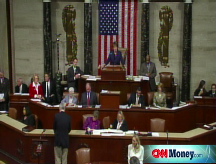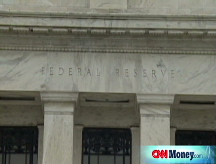Credit still choked, Treasurys rally
European bank problems add to investors' concern, leading to tighter borrowing and a flight from stocks.
NEW YORK (CNNMoney.com) -- Credit markets were still choked Monday, as the financial crisis spread throughout Europe and stock markets around the world tumbled.
Treasury prices jumped higher as investors waited to see signs of relief.
"What we thought was going to be a contained domestic problem is definitely global," said William Larkin, portfolio manager at Cabot Money Management. "It is now rooted in Europe and it looks like it is probably spreading to Asia."
The European economy has been tripped by the same credit crunch that forced the $700 billion bailout plan signed into law by President Bush last week. Over the weekend, Germany implemented its own bailout package.
The private financial sector of Germany has pledged €50 billion to juice the Hypo Real Estate bank, the nation's Finance Ministry said Sunday. Hypo is one of Germany's largest housing lenders. The German government also stepped in to shore up consumer confidence by guaranteeing all private checking and savings accounts.
Even as banks in Europe struggle, the European Central Bank has maintained its key lending rate. "Everyone is waiting for a coordinated interest rate cut between many of the central banks," said Andrew Brenner, senior vice president at MF Global.
Market gauges: The 3-month Libor rate, or the London interbank offered rate, eased slightly to 4.29% from 4.33% Friday, according to data from Bloomberg.com. The rate is a daily average of what banks charge other banks to lend money in London and remained at elevated levels not seen since January. The overnight Libor rate increased to 2.37% from 2% Friday.
One indicator of how willing banks were to lend to other banks, called the "TED spread," showed high prices of loans between banks. The TED spread measures the difference between 3-month Libor and the 3-month Treasury bill, and is a key indicator of risk. The higher the spread, the bigger the aversion to risk.
The TED spread was at 3.78 percentage points and had reached as high as 3.95 points earlier Monday, setting another record, after moving as high as 3.88 points Friday. The TED spread was only 1.04% on Sept. 5.
The Libor-OIS "spread" measures how much cash is available for lending between banks, and is used by banks to determine lending rates. The bigger the spread, the less cash is available for lending.
The Libor-OIS spread hit its seventh consecutive record at 2.94 percentage points Monday before retreating slightly to 2.87 points, after climbing from 2.86 points Friday.
Dour outlook: As investors watched the credit crisis spread across the globe, they lost confidence in the financial system. "There is a really sour investor psychology right now," said Larkin.
The barrage of news has "people into the bunker mode," said Larkin. Rather than focusing on risky investments that promise high returns, investors "want to be sure that their principle is returned to them."
Another analyst echoed the sentiment. "The lack of confidence is at an all-time high," said Brenner. "Until that lack of confidence reverses itself, you will continue to have illiquid, dysfunctional markets."
Larkin said one key element for market psychology to return to healthy levels was a lack of institutional collapses.
In the wake of the bank failures on Wall Street, Larkin said investors were afraid to invest in corporate bonds. "You don't know what kinds of bombs could be hidden in their structure," he said.
Treasurys: Amid mounting uncertainty on Wall Street and in the credit markets, investors fled the stock market and dove into Treasurys, sending bond prices higher. The surge in bond prices Monday was "a classic flight to quality," said Brenner.
U.S. stocks plunged, with the Dow Jones industrial average dropping as much as 800 points, sinking below 10,000 for the first time in nearly four years. The Dow's losses eased late in the session, and Treasurys fell from their highs.
Asian markets ended also down 4% to 5%, Europe's major indexes were about 5% lower.
The benchmark 10-year note rose 1-1/32 to 104-8/32 and its yield fell to 3.49% from 3.63% late Friday. Bond prices and yields move in opposite directions.
The 30-year bond jumped 1-24/32 to 108-26/32 and its yield dipped to 4% from 4.12% late Friday.
The 2-year note rose 8/32 to 101-2/32 and its yield fell to 1.46% from 1.66%.
The "2-10 yield spread," or the difference between the 2-year and 10-year yields was at a very high 2.03 percentage points, suggesting that short-term lending remained scarce and expensive. The spread has hardly budged in the past few days, even after the bailout bill was passed.
The yield on the 3-month note fell 0.43% from 0.49%. The 3-month note is a popular asset for money markets looking for stability because it offers a safe place to park cash on a short-term basis.
The 3-month note "is perceived to be the safest most liquid asset in the world," said Larkin, and "when the yield falls below 1%, that is a sign that people are fleeing other assets."
"That is a perfect example of fear," he added.
U.S. moves: As the government looks to fund the $700 billion bailout plan, it will raise money by selling more debt, according to a statement issued by the Treasury Department. The government also said it may reintroduce a 3-year note beginning next month.
In another attempt to help jump start the stuck credit markets, the Federal Reserve announced Monday that it would make hundreds of billions more dollars available to banks in exchange for troubled assets, such as mortgage-backed securities.
While the Fed's move to increase fund availability to banks was "very positive," according to Brenner, he also said that "it still is only one of many things that needs to be done."
Bailout aftermath: The goal of the U.S. bailout plan was to loosen the clogged pipes of credit. Banks have been sitting on their cash, unwilling to lend, and if they are lending, it comes at a premium. When banks don't lend, economic growth stalls and consumers have a hard time getting a loan for a house, car or tuition.
After weeks of belabored negotiating, and an initial failed vote in the House, the bill became law Friday.
The long, drawn out debate over the conditions of a government bailout worked to deteriorate market sentiment surrounding the effort, according to Larkin, who said the heated discussions "disclosed more problems, there was another layer of doubt that was built by the conversations."
"Dissent started to grow," said Larking, and "that does not make Mom and Dad at home feel any better. That prevents the psychology from healing."
But the bailout plan was not expected to be a quick fix. The plan will take some time to offer relief for the economy and even longer for that relief to trickle down to consumers.
President Bush, whose administration proposed the measure last month, has urged patience. "Americans should expect that it will take some time for this legislation to have its full impact on our economy," he said Friday. "This will be done as expeditiously as possible, but it cannot be accomplished overnight." ![]()








